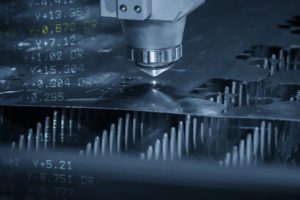Shining a Light on Laser Precision: Fiber Lasers vs. CO2 Lasers

In today’s fast-paced industrial landscape, precision is not just a luxury—it’s a necessity. Laser marking technology, heralded for its unparalleled accuracy and versatility, has revolutionized industries from aerospace to consumer electronics.
As with any technological innovation, there are choices to navigate. Among the most debated is the match-up between Fiber Lasers and CO2 Lasers. Both come with their own set of advantages, applications, and intricacies.
Fiber Lasers: The Contender
Fiber lasers are high-powered, solid-state laser sources that produce focused beams of light for cutting and welding applications. These lasers are constructed from doped optical fibers as the gain medium. The light is generated by pumping a seed laser beam through an optical fiber with amplifying material inside, which then passes through a series of optical mirrors before emerging at the other end at a much higher power than when it was inputted.
Fiber lasers provide a number of advantages over traditional CO2 lasers, such as:
- Superior precision
- Longer lifecycles
- Lower maintenance costs
- More energy efficiency.
With their ability to deliver consistent results at fast speeds with minimal waste and downtime, fiber lasers have become the technology of choice for many industrial applications.
Fiber lasers also offer greater efficiency than other laser technologies due to their wavelength-specific operation and ability to generate high power in a short amount of time. They are relatively low maintenance compared to other laser systems, making them an economical choice for many applications.
The versatility of fiber lasers makes them ideal for many different applications such as cutting thin metal sheets in automotive parts manufacturing or welding complex shapes in medical devices. They can also be used for marking materials including plastics and metals.
Furthermore, fiber lasers are becoming increasingly popular as they can be used with a wide range of materials and offer very fast processing speeds. This makes them an ideal solution for industries such as automotive, medical device manufacturing, and electronics. Fiber lasers are also becoming increasingly used in the printing industry for fine engraving and marking applications.
Fiber Laser Applications in the Automotive Industry
Fiber laser applications span multiple industries due to their high energy efficiency and precision. In the automotive industry, fiber lasers are used to mark parts with serial numbers, ensuring traceability throughout the part’s life cycle.
CO2 Lasers: The Challenger
CO2 lasers are a type of laser that uses carbon dioxide gas to generate a beam of light with a wavelength in the infrared range. The beam emitted from a CO2 laser has a high level of accuracy and can be used to produce detailed designs with complex shapes. It can also be used to cut and engrave intricate patterns on many different types of materials.
The power of the beam also allows for faster cutting speeds than those achievable with other technologies, making it ideal for precision applications that require quick turnaround times. Because the beam is relatively broad, it is easier to cover larger areas at a speed that would otherwise be impossible with conventional methods.
CO2 lasers are well known for their relatively low cost and versatility. They can also have higher power outputs than other types of lasers while still being able to cut through tougher materials like steel. CO2 lasers have been used in a variety of industries, from woodworking to metal fabrication and even medical fields. In the woodworking field, CO2 lasers are often used for engraving and cutting. For example, they can be used to engrave intricate designs on furniture or to cut out pieces of wood with precise measurements.
Real-world examples of CO2 laser applications
CO2 lasers are used to cut and engrave a wide range of materials, including wood, plastics, leather, glass, paper, and metals. Additionally, CO2 lasers can be used to cut or mill three-dimensional shapes from hard materials such as steel and aluminum.
In the automotive industry, CO2 lasers are used for cutting sheet metal with high precision and accuracy. For example, many car body parts like doors and engine covers are now produced using CO2 laser-cutting machines. In addition to precision cutting of metal sheets, CO2 lasers can also weld thin sheets together to form more complex structures.
Moreover, CO2 lasers are becoming increasingly popular in medical treatments such as:
- Skin resurfacing
- Hair removal
- Surgery.
They are more precise than traditional methods because their beams can target certain areas without damaging surrounding tissue.
Fiber Lasers & CO2 Lasers: Head-to-Head
While both types of laser technology offer similar power and precision, the efficiency of fiber laser machines is far superior. Fiber lasers can produce the same output as a CO2 laser with exponentially lower energy consumption and heat production.
Fiber lasers use up to 50% less electricity than their CO2 counterparts. Additionally, fiber lasers require much less maintenance, meaning fewer technical personnel and resources are needed for upkeep. This makes them ideal for industrial production environments where cost-effectiveness is a priority.
Fiber lasers offer a higher level of precision than CO2 lasers, making them more suitable for applications such as fine cutting in medical devices or intricate patterns on jewelry. The combination of high precision and low energy usage makes fiber lasers the preferred option for many industries.
In addition to their precise nature, fiber lasers also allow for faster cut speeds than CO2 lasers. This means that when it comes to completing large-scale projects quickly and accurately, fiber lasers are often the way to go.
Fiber Lasers vs. CO2 Lasers: The Bottom Line
CO2 lasers often produce higher power outputs than fiber lasers, making them ideal for applications that require cutting through hard materials such as metals. Fiber lasers typically are faster and are more energy efficient than CO2 lasers, making them ideal for precision machining and engraving.
When selecting the right laser for your needs, it is important to consider the output power requirements of the project, cost considerations, maintenance requirements, and any industry-specific considerations. It is also beneficial to consult with experienced experts to determine the best choice based on the specific application.
Technomark Knows Lasers: How to Learn More
Laser marking can be the most efficient method for part marking and traceability. If you’re looking for further details, consider downloading this resource:




